Marine Community Exhibit
Tang

Diet: Herbivores grazing on algae
Size: Most are 6-15 inches
Life Span: Up to 30 years
The distinctive characteristic of this family is the scalpel-like scale that has been modified at the base, the peduncle, of the tail. There may be one or two of these very sharp scales depending on the individual which helps protect these fish from danger. They have small mouths that have one row of teeth to allow them to graze on algae.
Engineer Goby

Range: West-Central Pacific Ocean
Diet: Carnivore including plankton
Size: 24 inches
Life Span: 3 years
Engineer Goby are eel-shaped fish that swim in tight formation schools to look like one organism. Juveniles resemble a poisonous striped catfish to fend of predators. During the day they will hunt for plankton and at night return to their burrows. During the day, the adults will continue borrowing, moving up to 6.6 pounds of sand. Some burrows reach the length of 6 meters. Adults will take in mouthfuls of juveniles and spit them out again collecting a green slime for their food source.
At night, young fish dangle by their mouths from the roof of the tunnels by thin mucous threads.
Mandarin Goby
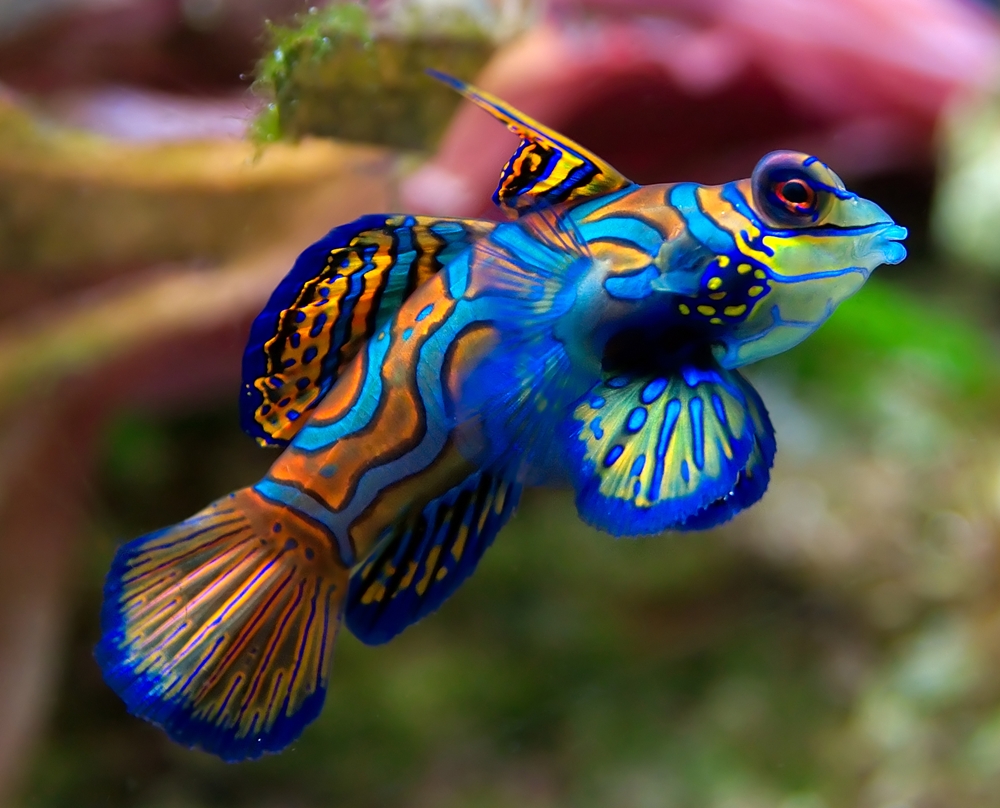
Range: Pacific Ocean
Diet: Omnivores including algae, small crustaceans and invertebrates and fish eggs
Size: 2-4 inches
Life Span: 10-15 years
Mandarinfish have a layer of smelly and bitter slime instead of scales which helps to block disease. This and its bright coloration discourages predators from attacking.
They have large pectoral fins that allows them to “walk” on the sea floor while their pectoral fins are near their center and are nearly transparent. Their name comes from their bright coloration evokes the image of the robes of an Imperial Chinese mandarin.
Lightning Maroon Clownfish
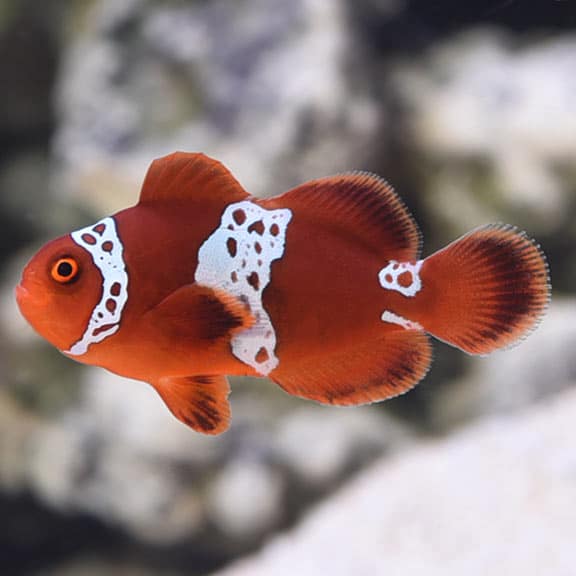
Range: Warmer waters of Indian Ocean, Red Sea, and Pacific Ocean at the bottom of shallow seas in sheltered reefs or lagoons. No Clownfish found in the Atlantic Ocean.
Diet: They are omnivores. They can eat the undigested food from their host anemones, zooplankton and algae.
Size: 3-4 inches
Life Span: Up to 10 years
Clownfish host anemones and they create a symbiotic mutualistic relationship. The anemones protects the clownfish from predators and provide food through their scraps and in return the clownfish defend the anemones from predators and parasites.
The mucus coating of the clownfish is based on sugars rather than proteins which makes the anemone fail to recognize them as a food source and does not sting them.
Pajama Cardinal Fish
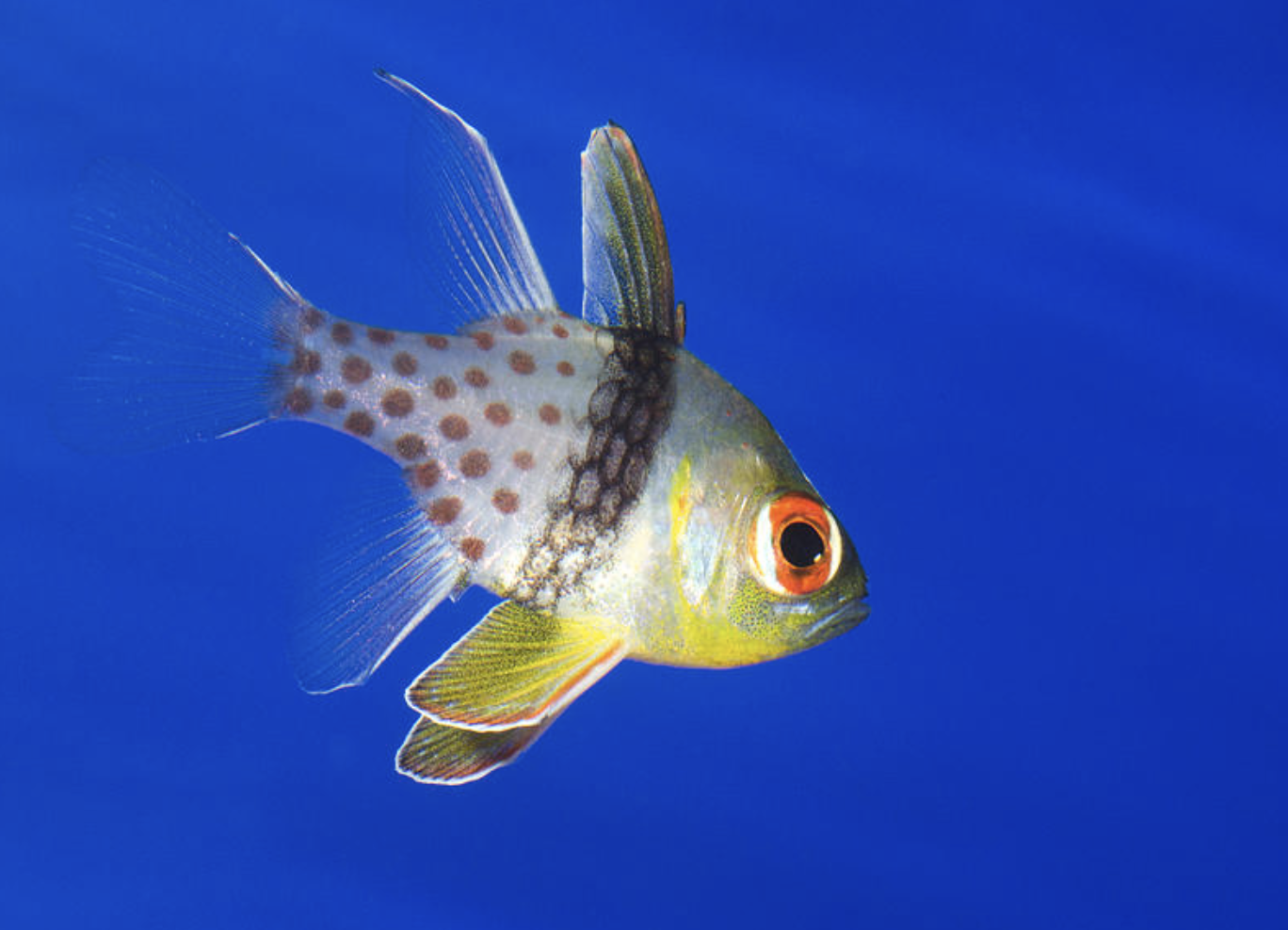
Range: Western Pacific Ocean
Diet: Carnivore including small invertebrates
Size: 3 inches
Life Span: 5 years
Male pajama cardinal fish incubate eggs in his mouth until they hatch. Once they hatch, he spits them out and then they are on their own.
The black band helps camouflage them with the spines of sea urchins and coral structures. They hang out in small schools and found hovering in one place by caves or corals. At night though they will split from their school and go hunting themselves. Their huge eyes make it easier for them to see at night.
Regal Blue Tang

Range: Indo-Pacific, Great Barrier Reef
Diet: Zooplankton in the wild
Size: Up to 12 inches
Life Span: 8-20 years
The Regal Blue Tang is known by many names among which is the Blue Tang and Blue Hippo Tang. They are part of the surgeon fish family which the defining characteristic is the scalpel-like spine on the base of their tail. For the Blue Tang, the spine is yellow and located on the yellow part of their tail. It is used as a mode of defense towards threatening fish.
They eat algae which is instrumental in coral reefs because it keeps algae at low levels so that they don’t choke out corals. The Regal Blue Tang has a small mouth and a single row of teeth to help them get into the tight crevices of rocks and corals.
Regal Blue Tangs live in pairs or in small groups or schools of 8 to 14 individuals. Males will aggressively court the femals and they can quickly spawn. They release the eggs and sperm in the evening time where they float near the surface of the water because of a tiny droplet of oil in each egg. The eggs will hatch within 24 hours of being fertilized.
We don’t recommend eating them. It is used as bait fish in commercial fishing because of the strong odor on the flesh from certain toxins. If consumed by people, then it causes ciguatera poisoning. Symptoms include diarrhea, vomiting, numbness, itchiness, temperature sensitivity, dizziness, and weakness.
Panther Grouper
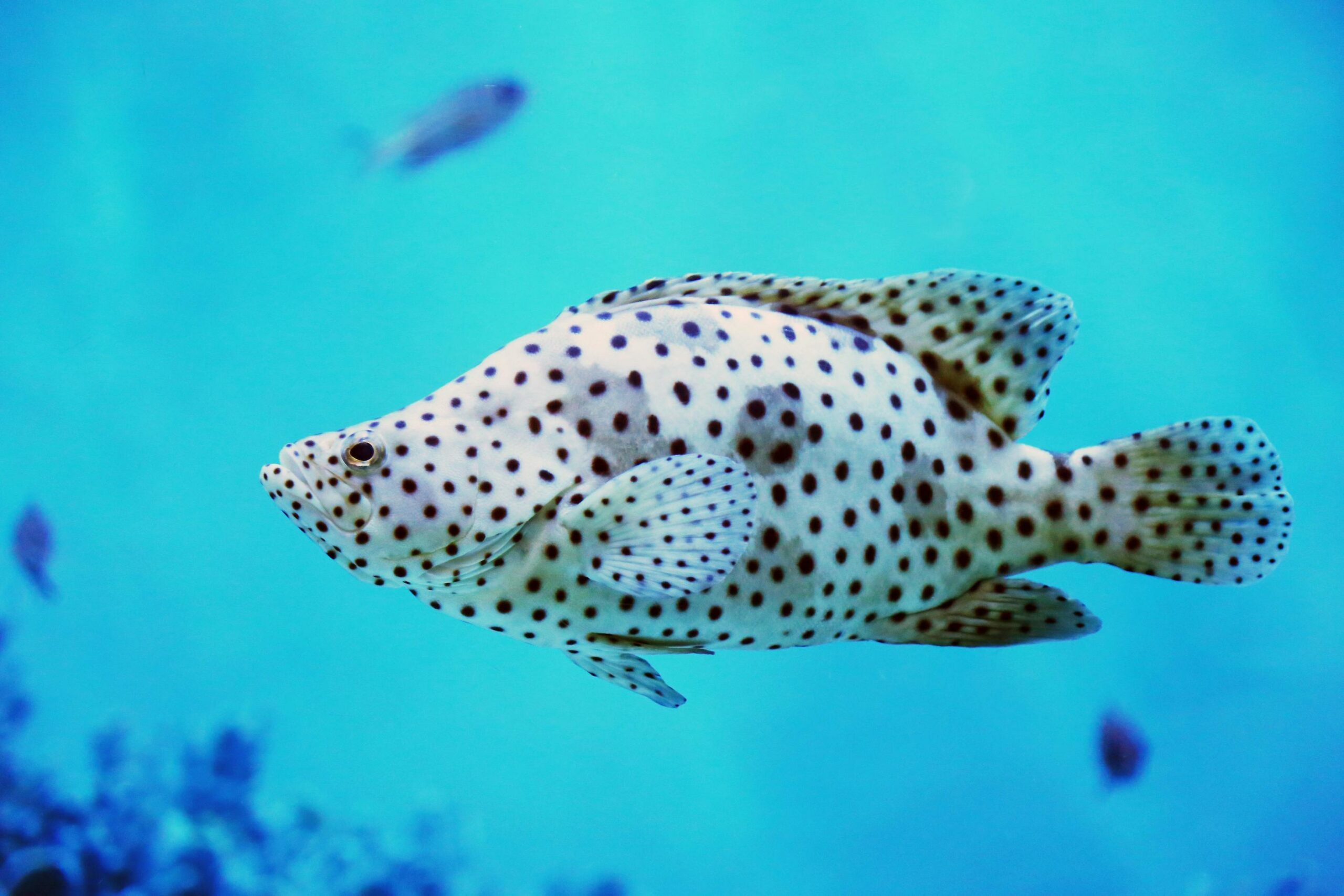
Range: Western Pacific Ocean
Diet: Carnivore including fish and crustaceans
Size: 28 inches
Life Span: 19 years
Grouper because of the way it is shaped. As a juvenile they swim with their heads downwards and as they get older they start to add more grays and beige into their coloration.
They are an ambush predator so they wait until the prey is close enough for them to attack. Groupers are territorial and solitary preferring to have their own space.
Flame Angelfish
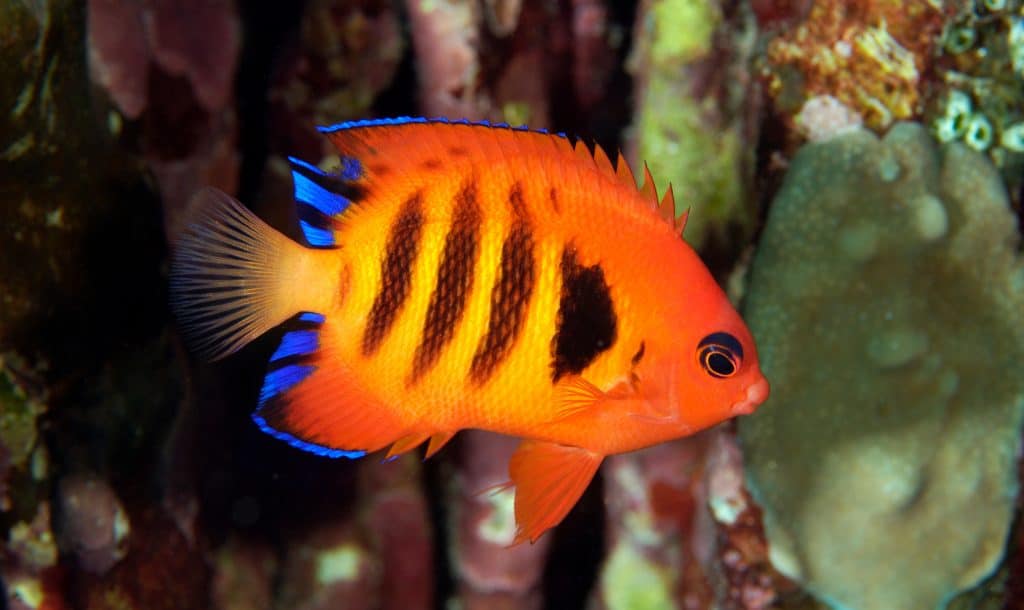
Range: Tropical waters of the Pacific Ocean
Diet: Omnivore including algae and crustaceans
Size: around 6 inches
Life Span: 5-7 years
The Flame Angelfish are also known as the Japanese Pygmy Angelfish. Flame Angelfish are a type of dwarf angelfish so they only grow to about 6 inches where as a full size angelfish is between 8-12 inches. Dwarf angelfish are also considered reef safe as they don’t normally nip at corals whereas the full size angelfish are not considered reef safe as they have a tendency to nip and eat corals.
Horseshoe Crab

Range: Atlantic Ocean
Diet: Carnivore including worms and mollusks
Size: 14-19 inches
Life Span: 20 years
The name crab is misleading because they are not true crabs or even true crustaceans. Horseshoe Crabs are considered living fossils because of their origin of 244 million years ago.
Their mouth is located in the center of five pairs of legs. After the legs are the book gills which exchange respiratory gases and sometimes used for swimming.
Horseshoe crabs use hemocyanin to carry oxygen in their blood and the copper present in hemocyanin makes their blood blue. Their blood contains amebocytes which is similar to out white blood cells in defending against pathogens. Amebocytes are used to detect bacterial endotoxins in medical applications.
Cleaner Shrimp
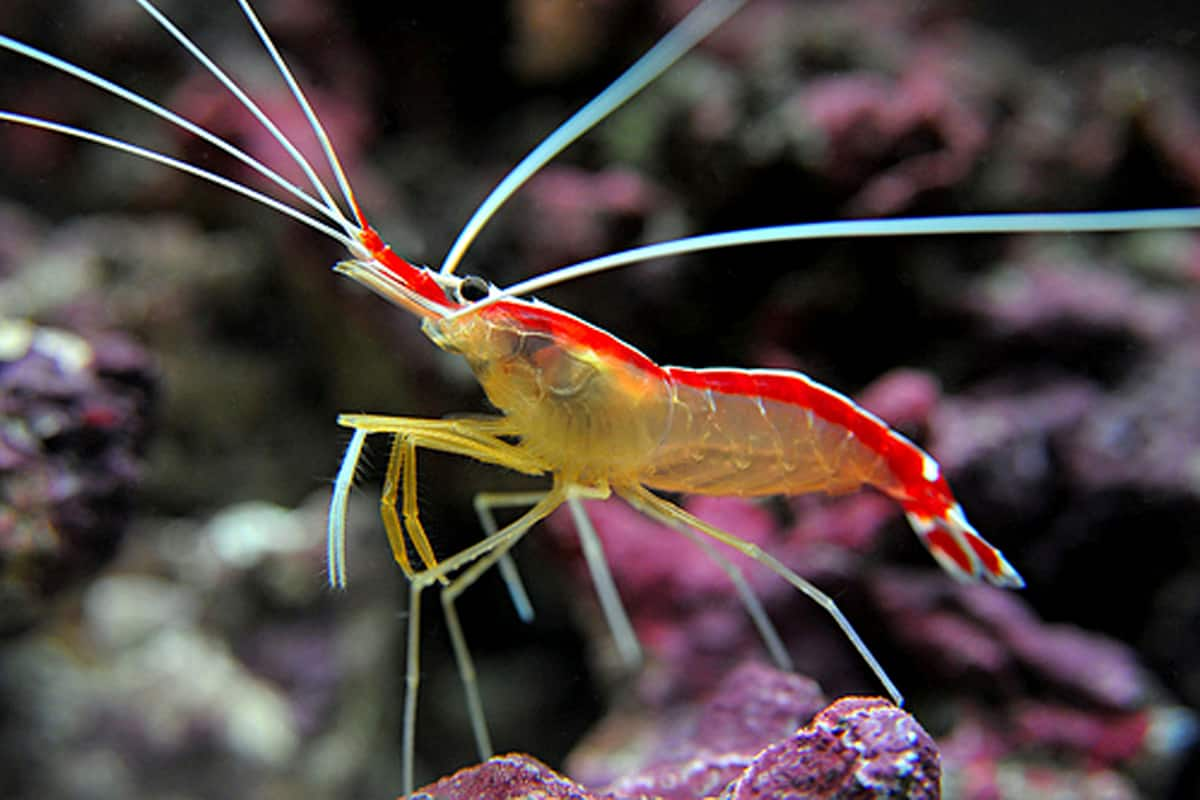
Diet: Omnivore including algae, detritus and dead fish tissue
Range: Africa, Indonesia, Sri Lanka
Size: 2 inches
Life Span: 3 years
Cleaner shrimp have a mutually beneficial association with fish. The fish benefit of having parasites removed from them and the shrimp gain the nutritional value of the parasites. Shrimp will also clean around wounds of fish from parasites and mucus which decreases infections and stress, and helps healing. Shrimp will congregate in cleaning stations.
Pencil Sea Urchin
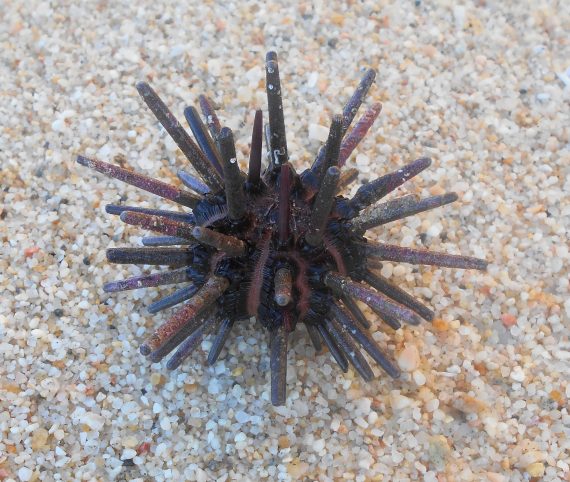
Range: Indo-Pacific Region
Diet: Herbivore including coralline algae
Size: 3 inches in diameter and up to 4 inch spikes
Life Span: 30 years
The Pencil Sea Urchin has thick round spines that allow it to bore into hard substrates to defend itself, wave drag, and pressure. Its spines are made of magnesium calcite that is arranged so that there is a porous network to allow fluids and other organic matter to pass within them. The closer the spine is to the body, the less porous it is.
Midas Blenny
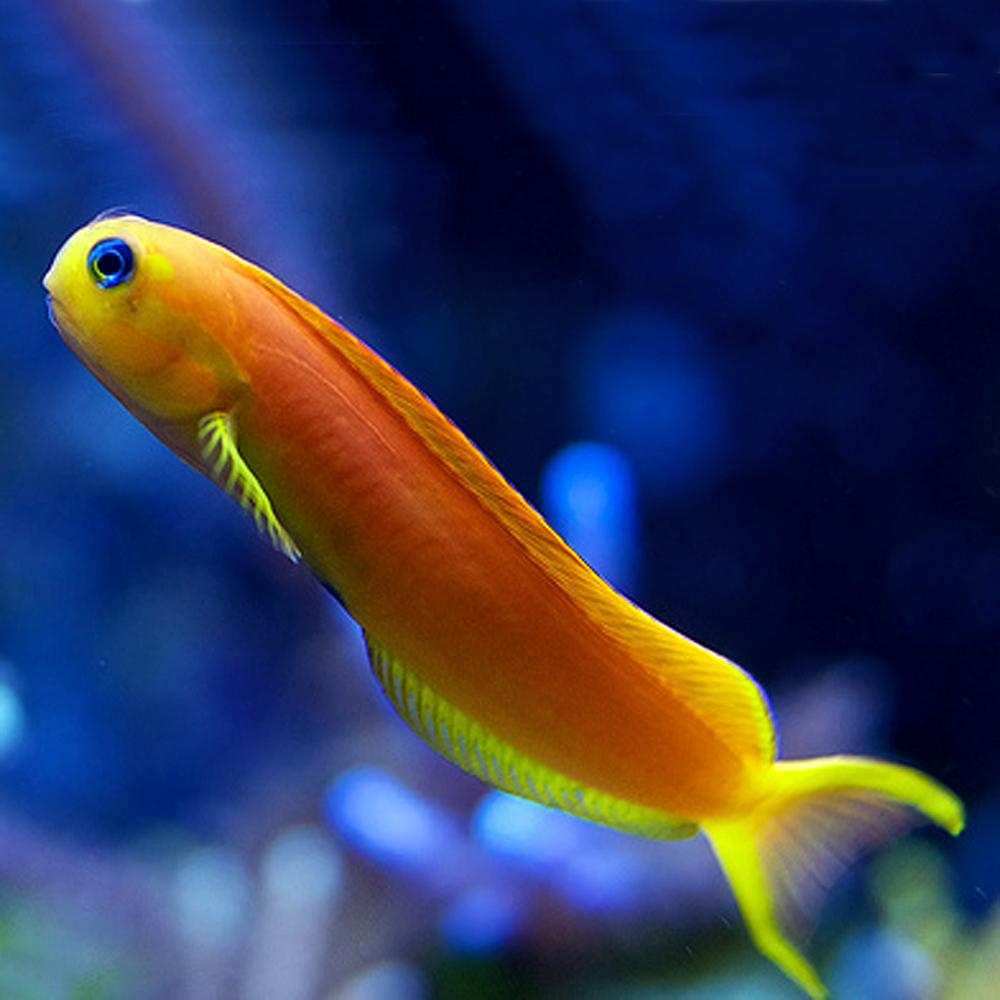
Range: Indo-Pacific from eastern Africa to Marquesan Islands
Diet: Omnivore. This includes mysis, brine shrimp and algae
Size: up to 5 inches
Life Span: between 2-4 years
The Pencil Sea Urchin has thick round spines that allow it to bore into hard substrates to defend itself, wave drag, and pressure. Its spines are made of magnesium calcite that is arranged so that there is a porous network to allow fluids and other organic matter to pass within them. The closer the spine is to the body, the less porous it is.
Blue Legged Crab
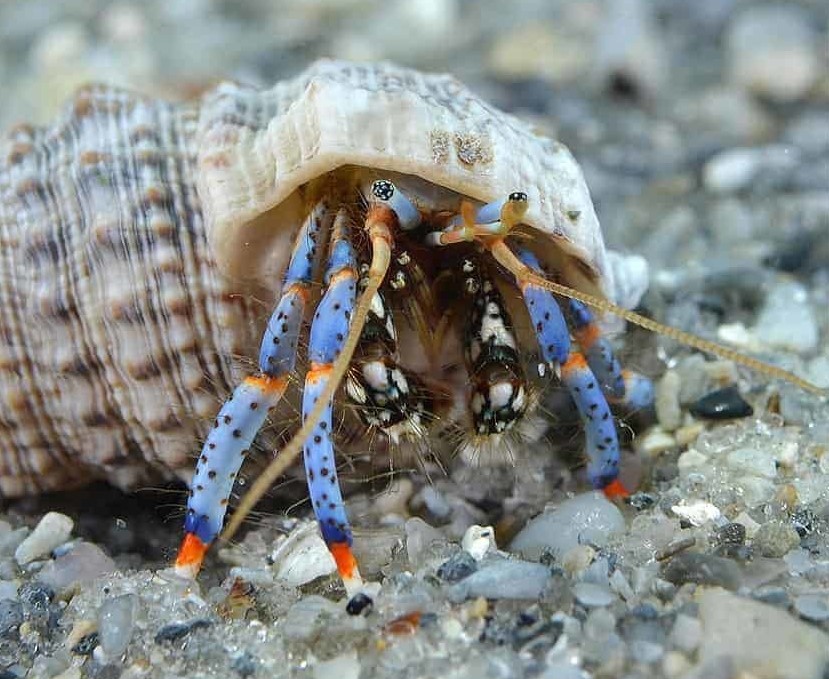
Range: Caribbean Sea
Diet: Detritivore including dead plants and animals and algae
Size: 1 inch
Life Span: 2 years
The Blue Legged Hermit Crab sifts through the sand looking for food. In the aquarium world they are considered to be part of the cleanup crew
They change shells and if they cannot find one then they will temporarily hide by an anemones foot for protection. They also molt their exoskeleton as they continue to grow.
Coral
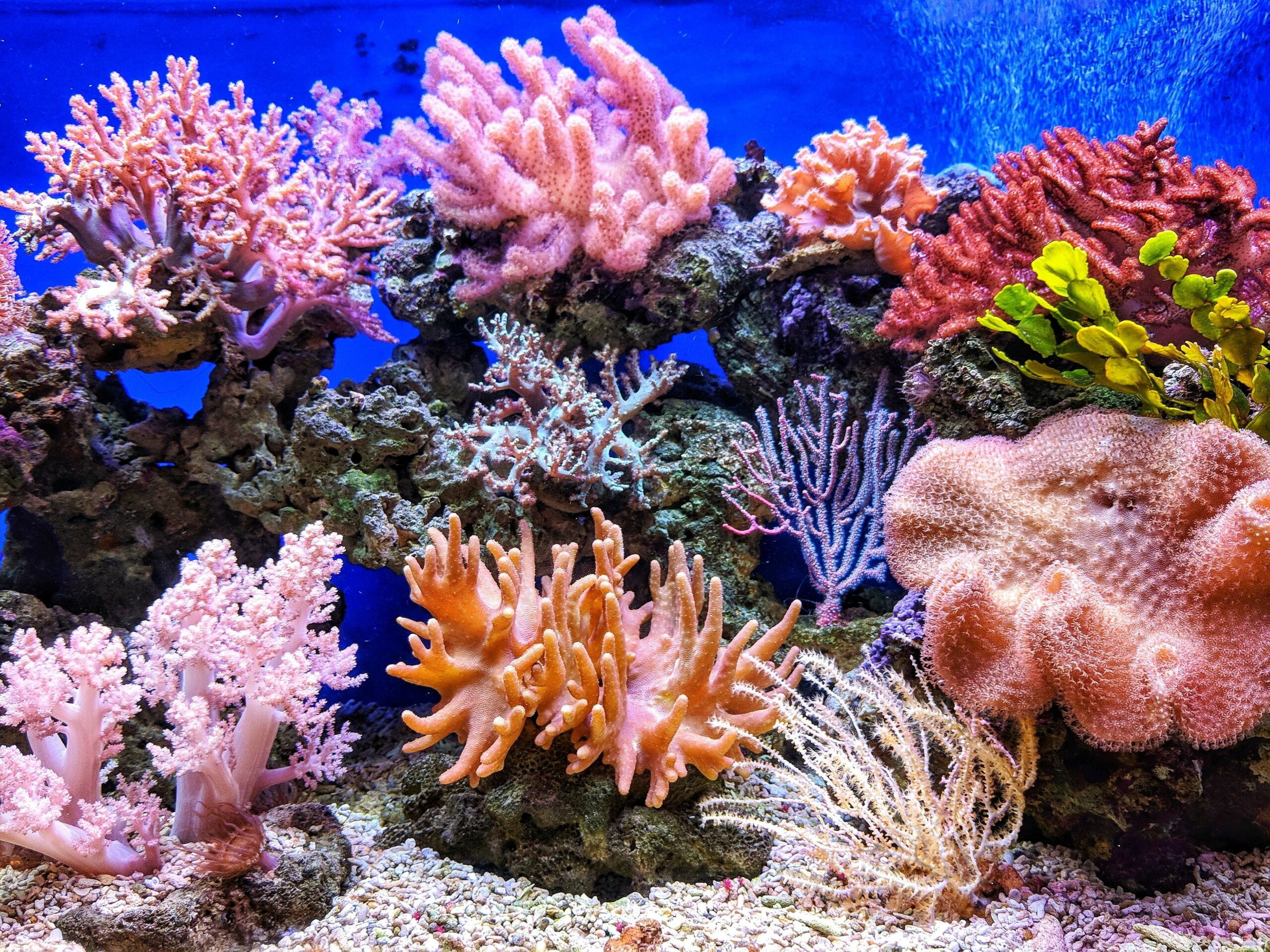
Range: Coral reefs are found in warm shallow water. There are corals in depths up to 300 feet
Diet: Carnivore. Depending on the polyp they can eat anything between a zooplankton to small fish
Size: each polyp is a few millimeters in diameter and a few centimeters high. Over generations the colony creates a skeleton that can measure up to several meters across.
Life Span: Individual polyps can live between several years to over 500 years depending on species
Corals are marine invertebrates that live in compact colonies of identical individual polyps. They have tentacles that can sting and bring their food to their stomach. Once they are done digesting, they expel their waste through the same hole as their mouth.
There are two types of corals. Hard corals live in colonies are look like rock-like formations. Soft corals look like plants.
Corals have a symbiotic relationship with zooxanthellae that photosynthesizes and gives the coral energy, nutrients and color.
Under high stress the polyps of the coral will expel the zooxanthellae going through a bleaching event. This increases their chance of survival for a short time but if the stress persists then the polyp can die.
Coral reefs have an extreme diverse ecosystem which can host over 4000 species of fish, cnidarians, mollusks, crustaceans and many other animals.
Star Polyp
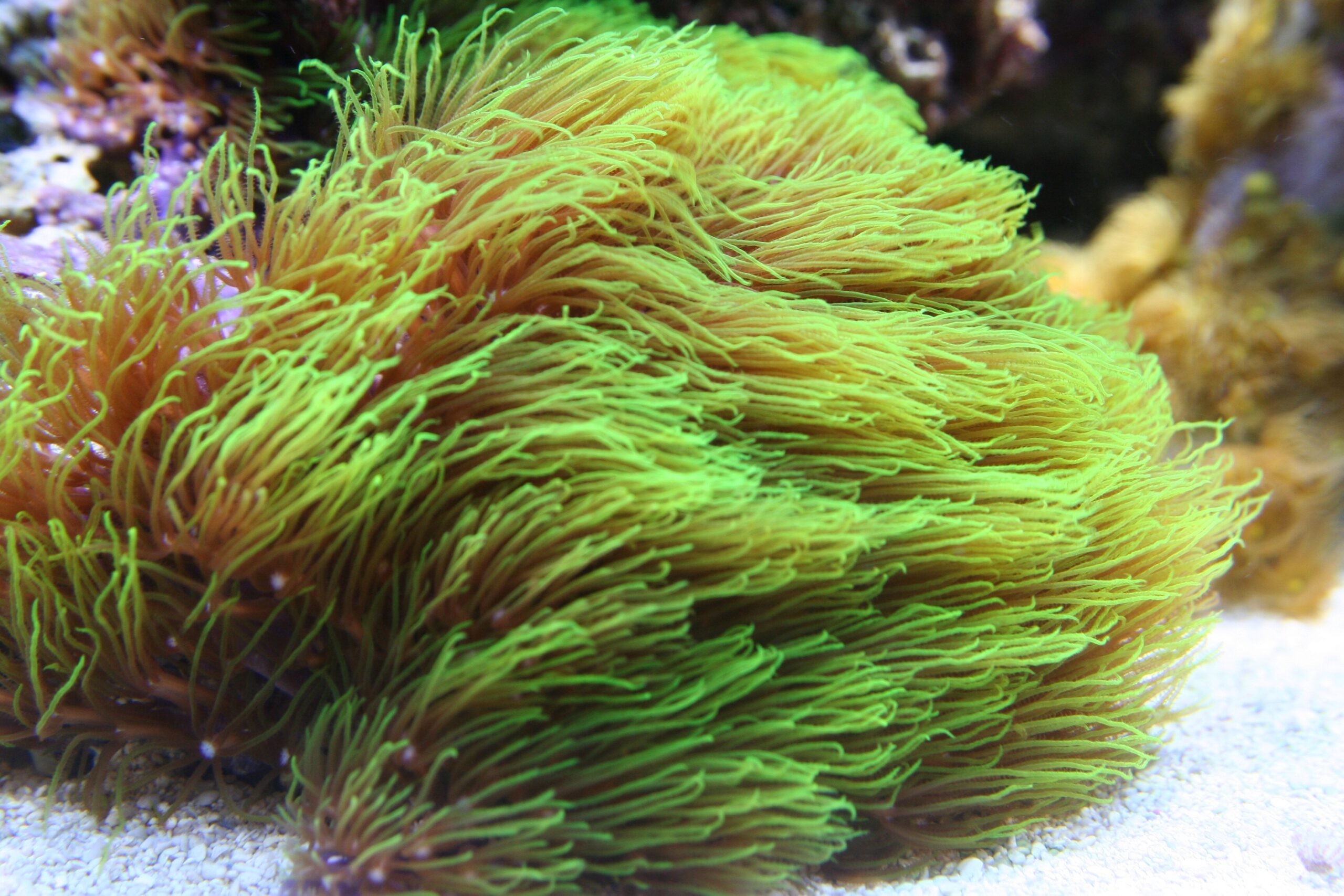
Range: Indonesia
Diet: Photosynthesize and eat micro plankton
Life Span: several hundred years
They have distinctive eight-leaved tentacles on each polyp. Each individual polyp is an animal and they live in colonies. They are a type of encrusting coral and will grow over rock and other corals. They can retract as a defensive mechanism and are considered peaceful.
Corals have a symbiotic relationship with zooxanthellae that photosynthesizes and gives the coral energy, nutrients and color.
Mushroom Coral

Range: Caribbean
Diet: Crustaceans, small fish, brine shrimp
Size: 1-2 inches
Life Span: 2-13 years
They are of the phylum Cnidaria which is the same phylum that the jellyfish are in. There are many species in this family that range to solitary corals to colonial species. The ones that are in this tank are colonial. Each one of those individual “mushrooms” is one individual that are living together in a colony. They can remain detached from the sand or rock so that they could move around if they wanted to.
They are very hardy corals which is perfect for the beginning aquarists. They can tolerate high levels of nitrates and other organic compounds that will usually kill other fish and corals. However, they will brighten and be healthier with less levels of nitrates and organic compounds.
These corals can be blue, red, green, brown, purple and sometimes with stripes, spots, or mottled color variations.
They will also reproduce until they cover the substrate on what they grow.
These corals will also host the zooxanthellae in a symbiotic relationship. The zooxanthellae provide it nourishment from the sun by photosynthesizing up to 90% of the coral’s energy for metabolism, growth, and reproduction. In return, the coral gives them nutrients, carbon dioxide, and an elevated position towards the sun.
Leather Corals – sinularia
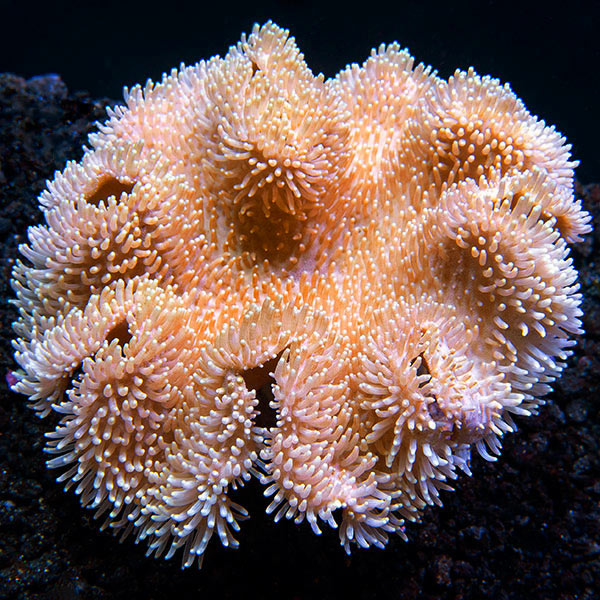
Range: Tropical waters of Pacific Ocean and Red Sea
Diet: photosynthesis and zooplankton
Life Span: 2-13 years
Leather corals are a soft coral with visible polyps all over them. Since they are a soft coral they do not have a calcified skeleton structure. They have the ability to sting other corals as well as emit chemicals to ward off other corals from entering into their space.
We have the:
Umbrella Leather
Toad Stool
Bubble Tip Anemone
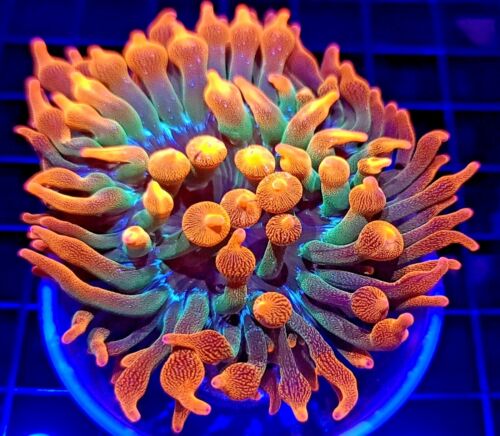
Range: Tropical waters of Pacific Ocean and Red Sea
Diet: Omnivore. Filter feeds with its tentacles
Size: 1 foot in diameter
Life Span: 100 years
Anemone is able to photosynthesize by its symbiotic relationship with zooxanthellae and collects nutrient through them.
Also, has a symbiotic relationship with anemonefish. The anemone provides shelter and defense for the anemonefish while the fish provides food and defense against other predators.
The tips of the anemones will have the bulbs based on flow, light, bacterial count, color, and if its hosting or not
